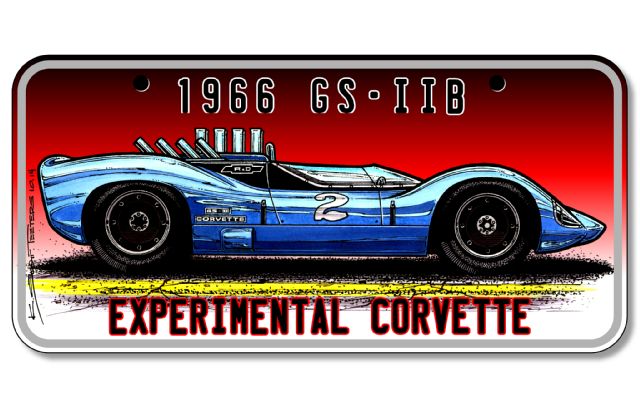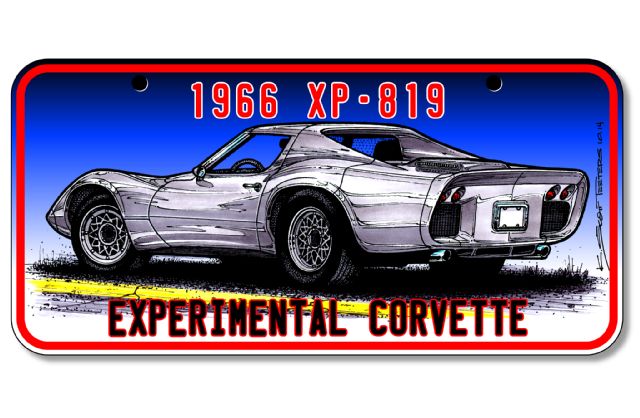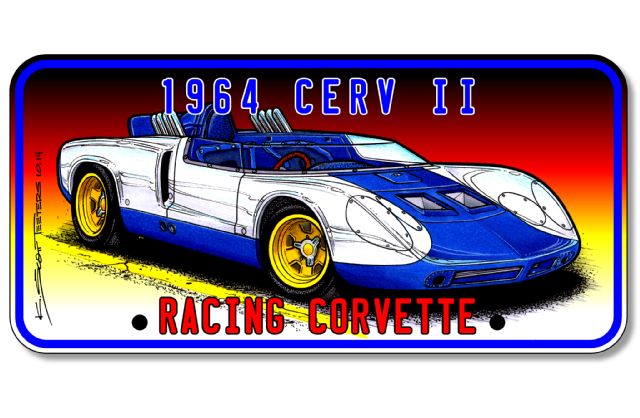
A look back at Chevrolet’s experimental, prototype, concept car, and show car Corvettes Part 6
Words and Art by Scott Teeters as republished from Vette magazine online at SuperChevy.com. Read the other experimental stories HERE.
General Motors makes hundreds of kinds of cars and trucks. Some sell hundreds of thousands of units a year, which makes Chevrolet’s Corvette a complete enigma. Given the small number of Corvettes sold every year, it is a modern American manufacturing miracle that the car survived for 61 years.
The Corvette was “officially” born on January 17, 1953 at the GM Motorama Show at the Waldorf Astoria Hotel, in New York. To understand the impact of Harley Earl’s two-seater sports car concept car, you have to look at typical cars of 1953. The car was low and sleek, and wasn’t over festooned with styling gimmicks. Based on the response from attendees, Chevrolet rushed the car into production, and the rest is history.
Today, the Corvette is GM’s flagship car. When Chevrolet unleashes a new Corvette, the automotive world stops to take notice. But things were not always this way. Up to the C4, there were many inside GM that wanted to see the Corvette go away. For the first 20-some years, the car suffered from an identity crisis.
Inside GM there were always those that wanted the Corvette to be something different; a lightweight sports car, a mid-engine car, a rear-engine car, a four-seater personal luxury car, powered by a boxer-type flat-six, Wankel rotary-powered, turbocharged small-displacement hemi-headed double-overhead cam powered, and even an all-aluminum car. Chevrolet kept the loyal faithful stoked with two or three experimental, prototype, show car Corvettes per year. From an enthusiast’s perspective, this was endlessly fascinating.
This is part six of a chronological look back at Chevrolet’s high-profile experimental, prototype, concept car, and show car Corvettes. Some of the cars had exotic names such as, “Astro-I,” “Astrovette” and “Geneve.” Others had experimental prototype numbers, such as “XP-700” and “XP-882.” And some had sexy names, such as, “Nomad,” “Mulsanne,” “Snake Skinner,” “Mako Shark,“ and “Tiger Shark.” In retrospect, a few of the cars were the shape of things to come, but most were simply, “Here’s an idea of something we’re working on.” Either way, it was all a ton of fun!
1964 Corvette GS-IIB

While Zora Arkus-Duntov lead the charge when it came to racing Corvettes, he wasn’t the only power player inside Chevrolet with a vision for a mid-engine Corvette. Frank Winchell was a low-profile company man who, unlike Duntov, did not like or seek out fame and attention. He was comfortable in his role as a corporate man. Winchell ran the Chevrolet R&D group from 1959 through 1966 and was a “take no prisoners,” “let’s try it” kind of guy. It was said that Duntov managed with love and enthusiasm, whereas nobody worked “with” Frank Winchell—they worked “for” him. Duntov and Winchell respected each other, but they often locked horns. Winchell guided the designs of three unique mid-engine concept Corvettes, but because of his personality and low profile, he’s largely forgotten. However, he did have an interesting vision for what the Corvette “could be” within General Motors.
Before all the bad publicity took the shine off of the Corvair’s star, the car was considered advanced engineering hardware. The transaxle and swing axle rear suspension was heady hardware, and R&D tinkerer types like Winchell and Duntov delighted in what could be done with the new addition to the parts bin. Winchell directed the construction of two cars using the Corvair’s flat-six engine and transaxle: the mid-engine Monza coupe and the rear-engine Monza SS. Both beauties were styled by Larry Shinoda and looked like, “When can we buy one?”
Winchell wanted to take the mid-engine/transaxle to the next level with V-8 power. The monocoque design structure was quickly replacing tube frame-type construction for advanced race cars, so a spot-welded, sheet steel tub was fitted with an aluminum 327 engine, an automatic transmission (considered “advanced” in the day), Weber carbs, and dragster-style zoomy headers. Winchell again drafted Larry Shinoda to design coupe and open roadster body configurations. Shinoda’s cars looked like they were ready for the GM Futurama at the 1964-’65 World’s Fair!
Winchell wanted his GS-II to be as light as possible, so in 1964 he had an aluminum monocoque tub built using the same suspension design, fully independent with the largest wheels and tires available, plus ultra-thin body panels that were bonded with 3M adhesive and oven-cured. The completed car weighed in at just 1,450 pounds! There’s no record of how much horsepower the engine made, but 400 to 425 hp would be a conservative guestimate. How fast you wonder? Winchell’s little GS-IIB rocket-blasted the Milford proving grounds at 198 mph.
Winchell’s bigger picture plan was to propose the initial construction of 500 GS-II coupes, with gullwing doors, to be used as street and track cars. The proposal sounds a lot like Duntov’s proposal to build 1,000 Grand Sport Corvettes to be sold through Chevrolet dealerships. Winchell had an interesting vision—one of a “family of Corvettes.” Imagine, regular production Corvette Sting Rays, along with the lightweight Grand Sport Corvettes, then the super-light GS-II Corvette. Perhaps Winchell should have proposed breaking the Corvette off into its own division within GM. There would have even been a place for the four-seater Sting Ray then. But we all know that wouldn’t have happened. Instead, Winchell let the grandstanding Duntov take the heat for the Grand Sport. So, no Grand Sport, and no GS-II.
The blisteringly fast GS-IIB drew too much attention, so Winchell hired the services of Jim Hall and his ultra-private Rattle Snake Raceway in Midland, Texas, for further R&D work on the concept. With the GS-II dead in the water, the car became an extension of Hall’s Chaparral series of race cars. Prototype racing sports cars were developing at an astonishing rate and it wasn’t long before the GS-IIB-based cars were eclipsed by new and improved designs. This was a very heady time, and Frank Winchell’s GS-II experimental Corvette played an important part.1964 XP-819 Corvette

Based on the very positive reception of the Corvair Monza GT coupe, with its then-exotic Corvair flat-six engine hanging out the back, Frank Winchell and his team wondered what a V-8-powered Corvair would be like. A mule was cobbled together and deemed worthy of moving to the next step as an experimental.
In a meeting, Duntov and Winchell got into a disagreement over whether the added weight of a V-8 could be compensated for with the right suspension/wheel/tire combo. The conversation deteriorated over aesthetics, with everyone agreeing that the car, with all that hardware at the back, would be an “ugly duckling.”
But Winchell, knowing that he was working on just that car, said he’d have to confer with his styling expert, Larry Shinoda. Larry said, “It could be beautiful. When do you want to see it?” Irv Rybicki. Director of Design, asked, “Do you have it done?” Shinoda told him he could see it after lunch! Shinoda and his team had been working on a full-size, tape sideview drawing and were almost complete. When the executives saw the full-size rendering, Duntov asked, “Where did you cheat?” Larry hadn’t, so Winchell’s team was given the go-ahead to build a prototype.
Larry Nies was the engineer assigned to the project and designed a steel backbone frame with a centrally located fuel tank. The suspension was fully independent and a 327 SBC was mated to a Pontiac Tempest transaxle. With a 90-inch wheelbase, this was a tiny, tight car. The Coke bottle sides tucked way under, so much so that part of the fixed seats were into the door and the steering wheel and pedals had to be adjustable. The radiator was front-mounted and steeply angled back, sucking in air from the lower front and exiting out the top of the hood. This helped reduce front-end lift but the vented hot air went straight back into the cockpit. Pop-up headlights were used on the pointed nose, the roof was Targa-style, and the one-piece tail lifted up. There were no structural bumpers. R&D’s computers calibrated the spring/antiroll bar combo and 11-inch-wide rear and 6-inch-wide front wheels were used. Shinoda designed the handsome basket-weave wheels.
For an oddball concept, it turned out better than expected. On the skidpad the XP-819 generated over 1 g, but its inside front tire was about 4 inches off the ground—foretelling of a more serious problem. One engineer reported that once the rear wheels slipped, the car was uncontrollable. With 70 percent of the car’s 2,700 pounds on the rear wheels, it was an excellent wheelie car! Eventually, the XP-819 crashed during a tire test on a wet road when equipped with same size front and back wheels. This was going to happen anyway.
With the Corvair was being savaged by the press, GM didn’t need any more “rear-engine car” negative publicity.
The XP-819 was repaired and loaned (given) to Smokey Yunick where it languished in his shop, ultimately being disassembled and put into a paint booth. In the late ’80s some enthusiasts spotted the remains in Yunick’s shop and recognized the XP-819. A deal was made and the car was rather crudely put back together. Yes, it still did wheelies.
A few owners later, the car ended up at Kevin Mackay’s Corvette Repair shop for a total restoration. Mackay said it was a tough project, but his team got it back to R&D condition. The chassis and running gear are now fully restored and the car has been on tour at Corvette shows as a driveable chassis—one of Mackay’s specialties. Sometime in 2015 the body restoration will be completed and the car will be put back together.
What’s obvious when looking at the restored chassis is that the XP-819 was more “kit car” than production car. The concept didn’t stand a snowball’s chance. It’s amazing it was built and more amazing that it has survived!
1964 CERV II Corvette

There’s a new metric in the world of performance sports cars called “The Two-Second Club.” To gain membership in this club, the car must accelerate from 0-60 mph in under 3 seconds. Members include the Nissan GT-R, Porsche 918 Spyder, Ferrari 458 Speciale, and the ’15 Z06 Corvette. The Nissan GT-R was the first production performance car to break into the “2-second” zone in 2012. The ’12 GT-R packs a 530hp, twin-turbo V-6 and all-wheel drive. All-wheel drive has been around since the 1890s and the first “official” AWD car was the 1903 Spyker.
Zora Arkus-Duntov was greatly influenced by the Auto Union and Mercedes race cars of the pre and post WW II era of racing. AWD was often part of the advanced engineering of the world’s best race cars, so it was no surprise that Duntov wanted AWD in his Corvette prototype to race at Le Mans. “Getting there” in a company that makes consumer cars would be a challenge, so Zora was limited to the parts bin. Duntov built his AWD racer using Corvair transaxles, which were considered cutting-edge engineering in 1964.
Duntov’s CERV II featured an alloy-steel tube frame and tub construction, with a 92-inch wheelbase. Zora planned to use one of three possible engines: either the all-aluminum 490hp/480 lb-ft of torque 377ci Grand Sport engine; a methanol-fueled, Hilborn-injected version of the 377; or a DOHC, three-valve-per-cylinder hemi-head version. Firestone supplied their new “ultra-wide” 9.5×15-inch racing tires. Unfortunately, the parts-bin AWD setup was doomed from the start. Duntov decided to use two small automatic transaxles, rather than one large automatic transmission and a heavy transfer case. While the car provided blistering acceleration and speed, the transaxles, which were never intended for racing, proved to be the weak link. Aerodynamics was another serious issue.
Larry Shinoda and Tony Lapine designed a sleek car, but it had horrible front-end lift. Duntov even commented that at 150 mph the car “wanted to fly.” A retractable rear spoiler, nicknamed the “cow tongue,” was added and helped a little. But forces more-powerful than aerodynamics would bring Duntov’s machine to a screeching halt.
When GM President Fred Donner caught wind of what Duntov and Chevrolet General Manager Semon Knudsen were up to, the hammer came down. At least the car didn’t go to the crusher. Through the ’60s, Duntov had CERV II retrofitted with various big-block combos, including an all-aluminum 427 ZL1, all under the guise of “testing.” The CERV II showed up on the cover of the November 1970 issue of Motor Trendwith the headline, “0-60 in 2.8 secs.” The claim was dubious because the article states, “calculations showed that with a low final drive ratio the CERV would accelerate from 0-60 in 2.8 seconds with a maximum of 115-mph.” Regardless, a 1,900-pound car with 600-plus horsepower and AWD is going to be mighty quick.
Years later the car was “on loan” to the Briggs Cunningham Museum, but in 1988, when the collection was sold off, Miles Collier bought the CERV I and CERV II for $50,000, then quickly resold the CERV II to Steve Hendrickson and Kerrie D. Jones for $300,000. GM sued to get the car back, but lost. In 2002, when Mike Yager, owner of Mid America Motorworks’ purchased the CERV II, it was in rough condition. Kevin Mackay and the Corvette Repair team were hired in 2011 to repair the Bondo and pop rivets damage to the body, fix the seized-up transaxles, and get the engine running. The most recent development on the CERV II was in November 2013 when the car sold at the RM New York Auction for $1,000,000! Duntov never would have imagined that.
